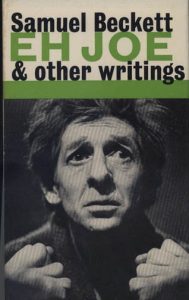Beyond the Fourth Wall: Experiments in TV Drama
- Samuel Beckett’s Plays on BBC TV
Samuel Beckett is probably best known as a theatre dramatist, but there is a long history of BBC TV presenting dramas that he wrote for specifically for the medium, and also television adaptations of his theatre work (Bignell 2009). In its 2012 season of screenings titled ‘Beyond the Fourth Wall: Experiments in TV Drama’, the British Film Institute screened a selection that comprised Beckett’s original television play Eh Joe (BBC 1966), and an episode of the arts series The Lively Arts (BBC 1977) that includes three of his dramas. These are visually distinctive plays, worthy of the term ‘experimental’, and the story of how they were made and received reveals fascinating relationships between Beckett, the BBC and different groups of viewers.
The commissioning and screening of Beckett’s plays by the BBC demonstrates a linkage between British television and an experimental Modernist aesthetic that Beckett’s name already represented in the later decades of the twentieth century. The formal experimentation, theatrical background and complexity of Beckett’s TV plays supported the Public Service claims of the BBC to present the best of contemporary arts practice despite, but also because of, the distance between some of that practice and the mainstream forms of television drama. The Modernist experimentation in Beckett’s plays on television can be seen in their pared-down verbal and spatial textures, and their concentration on geometrical forms and static or very slow physical action.
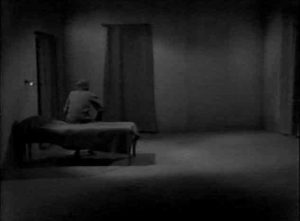
In Eh Joe, there is only one set, and the play opens with a wide shot of a space representing a room with an oddly-proportioned door and window, and a narrow bed. Joe (Jack McGowran) moves around the set, drawing curtains and seemingly shutting himself in. Joe never speaks in the 20-minute drama, but the audience hears a female voice (Sian Phillips) questioning him and berating him for his involvement in the death of a woman, probably his lover.
The camera moves in stages towards Joe, ending on an extreme close-up of his face, with no cuts between shots. The effect is to emphasise Joe’s reactions to the voice, which might be the voice of his conscience, and the play achieves a great intensity by means of its concentration on the single actor.
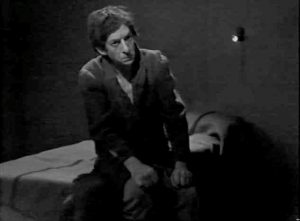
The recognition Beckett gained after the theatrical success of Waiting for Godot (first staged in the UK in 1955) and numerous BBC radio productions of his work that Martin Esslin oversaw as Head of Radio Drama, meant that Beckett was perceived by television producers as part of a cultural elite. Esslin himself commissioned Beckett’s media work and also published academic writing that emphasised its aesthetic significance.
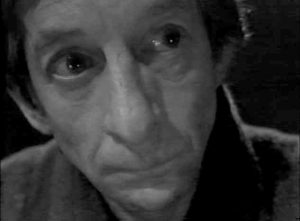
When Eh Joe was first screened, the Radio Times billing (30th June 1966) noted that ‘Eh Joe? [sic] was written specifically for television by Samuel Beckett, the Irishman long resident in France whose plays – Waiting for Godot, Endgame, Krapp’s Last Tape – have formed an important part of the post-war theatre revolution’. In the early 1960s, the BBC produced many dramas exploring television form and drawing on European arts culture. For example, a TV version of Beckett’s Krapp’s Last Tape was screened in 1963 in the BBC’s Festival anthology series, in which an adaptation of James Joyce’s Ulysses and plays by Jean Cocteau and T.S. Eliot were broadcast. But Beckett’s plays mainly featured in arts series, and it was in BBC2’s Lively Arts that ‘Shades’ was screened in 1977. The programme included three plays by Beckett; Not I was a version of a theatre play first staged in London in 1973. Ghost Trio was written specially for television, as was … but the clouds ….
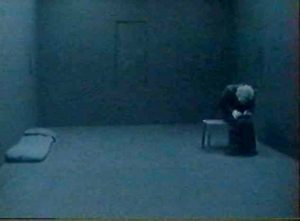
Initially the space in Ghost Trio looks like the pared-down room of Eh Joe, containing a door, window, bed and a single performer (Ronald Pickup) sitting hunched on a stool, holding a cassette player. A female voice (Sian Phillips) describes the setting, instructing the viewer to look at still images representing the rectangular objects within it. She appears to preside over the space, and announces the movements that the male figure will make (walking to the door, the window) and that he will hear ‘her’, a woman who we assume he is waiting for. The woman does not arrive, and instead the man returns to his stool and hears music on his cassette player, Beethoven’s 5th Piano Concerto (known as ‘The Ghost’). The action is divided into three similar sequences, in which the camera moves into the space and closes up on the man’s bowed head, raised for the last time towards the camera in the final shot.
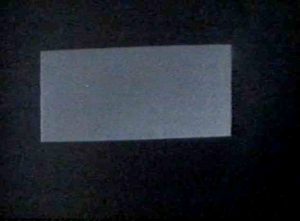
As in Eh Joe, camera movement is slow and repetitious, takes are long and there are few cuts. A male performer and a female voice disconnect sound from vision, and the schematic setting questions any temptation to understand the action as ‘realistic’. Instead the play seems to be about loss, memory, expectation and resignation.
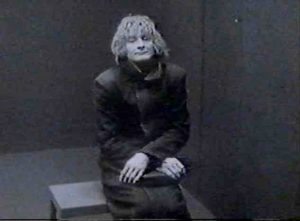
The third drama in ‘Shades’ develops similar ideas, beginning with a shot of a hunched male figure against a featureless black background. A male voice slowly speaks of times when, at night, having returned home from tramping the roads, he thought of a woman. Reconstructing these occasions slightly differently each time, the camera cuts from the hunched figure to a lighted circle of space into which a man walks, stops, then walks away again. The absent woman is represented by a shadowy female figure, inaudibly mouthing a few lines from W. B. Yeats’ poem ‘The Tower’ that include the words ‘but the clouds’. The separation of sound and image occurs again in this play, together with the attempt to evoke the past, though the absent loved-one is associated with poetry rather than music. But the activity of remembering and awaiting her ‘ghostly’ appearance continues Beckett’s concern with how both language and vision summon up, yet draw attention to the absence of, something or someone that cannot be recaptured.
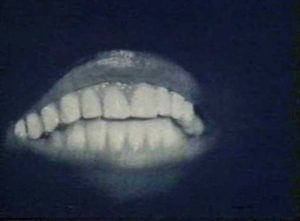
An interest in vision, language and identity are also important to Not I. There is only one shot; the camera stays in close-up on a mouth speaking for the whole of the play’s 15 minute duration. The character is a woman (Billie Whitelaw) who speaks very rapidly about how, at the age of around 70, she becomes suddenly able to speak. Disconnected, repeated phrases tell fragments of her story, but whenever she is about to refer to herself as ‘I’ she stops and switches to the third person, ‘she’.
She seems unable to take on the subjectivity that language would define for her. As the play progresses the mouth’s shape, movement and materiality (the detail of lips, teeth, saliva) become mesmerising, both intensely physical but also abstract and disassociated from the rest of the body.
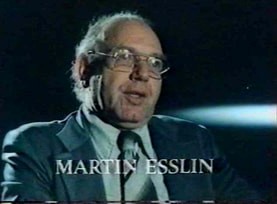
The Lively Arts ‘Shades’ was planned as a tribute for Beckett’s 70th birthday in 1976, but problems deciding what to include delayed it and gave time for Beckett to write Ghost Trio and …but the clouds… specially for the programme. The Lively Arts usually featured interviews with writers, artists and other cultural figures, but Beckett refused to be interviewed and instead introductory material and a discussion between Martin Esslin and the presenter Melvyn Bragg was shot.
The links between Beckett and a tradition of experimental literature, theatre and art were explored in the discussion, and were signalled visually by shots of paintings by Henri Hayden, Edvard Munch and Francis Bacon, and sculpture by Alberto Giacometti.
Beckett’s television plays draw on aesthetic forms and production practices that associate them with early television drama and with theatre. Until the late 1950s, British television drama was shot in relatively long takes, and many of the dramas were excerpts from, or adaptations of, theatre performances. The dramas were live, because of the impossibility of prerecording. But as Jason Jacobs (1998) has shown, there were strategies to create visual dynamism, by changing the composition of a shot, changing the relationship between the performer and the set by physically moving the camera closer to, or further from, the action. Pace and dynamism were created by camera movement rather than by editing. Beckett self-consciously uses this technique in his screenplays, by closing-in in slow and deliberate steps in Eh Joe, for example, or by moving the camera across the acting area in Ghost Trio. However, the length of shots in Beckett’s dramas is still much greater than the average for British television drama after the Second World War, and the camera movement is much slower. The dramas concern only one visible performer at a time, so the dynamic movement made possible by panning between speakers, or by changing the framing to include or exclude one performer from a group, is unavailable. Beckett’s television dramas, whether written specifically for TV or adapted for television production, alluded to a superseded aesthetic and refused many of its visual possibilities.
The commissioning of original dramas by Beckett as a writer associated with theatre, and also the presentations of his theatre plays on television, advertised the theatre medium as an important cultural institution. The Radio Times (30th June 1966) billing for Eh Joe, for example, noted connections between the performers in the play and both television and theatre productions: ‘The distinguished Irish actor Jack McGowran has for long been a close personal friend of the author, and he has become (with Patrick Magee) one of the principal interpreters of his work. He is also one of drama’s most skilled pantomimists, as evidenced by his recent television performance as the jockey turned Trappist monk in Silent Song. Sian Phillips, the voice of Joe’s past, has been seen recently in the West End theatre in The Night of the Iguana and Man and Superman.’
But the cultural power of Beckett, his BBC collaborators and the distinguished performers in the plays was at odds with the audience reception of the television plays.
The BBC Audience Research Report on Eh Joe (BBC WAC T5/1296/1) shows that 3% of the viewers in the BBC’s audience sample watched the play, and the Reaction Index for the programme (a measure of appreciation) was the low figure of 49. Several viewers liked the use of monologue over silent images, and one viewer wrote ‘obviously television could be the medium for this sort of thing, and it is a good experiment’. But many viewers thought the play was very depressing. A third of the sample said it was dull and dreary, with no visual appeal.
Clearly, Beckett’s cultural prestige was sufficient to overcome such negative factors. In fact, it was the recognition of Beckett’s significance among the powerful but tiny audience of cultural commentators and opinion-formers that legitimated the BBC’s continued investment in Beckett’s work. Press reactions to ‘Shades’ exemplify this. Sean Day Lewis reviewed it for the Daily Telegraph (16th April 1977), and wrote: ‘Casual viewers who stray into The Lively Arts […] tonight are likely to think that something has gone seriously wrong with their sets. […] The shades are all grey, Beckett does not believe in colour television, it seems, just in case too much information is let loose. And then the grey is made as misty as possible so that the characters are dimly perceived. This Tristram Powell production is not to be missed by those of us who are Beckett admirers, but it is uncompromising and may not make converts.’
In Britain there has always been a tension between television’s Public Service responsibility to raise the cultural standards of audiences, and the requirement to entertain. Broadcasts of Beckett’s television work show that the BBC could ignore negative audience responses and small numbers of viewers and present ‘the best’ of arts culture as defined by BBC personnel and an informed reviewing culture in the press. The casting of high-profile theatre actors in Beckett’s television work, and the images of art-works by Bacon and Giacometti in ‘Shades’, for example, link Beckett’s plays to a valued European (and not just British) arts culture.
By Prof. Jonathan Bignell
Jonathan Bignell is Professor of Film and Television at the University of Reading. Author of Beckett on Screen: the Television Plays (Manchester University Press, 2009), he works primarily on television history and the methodologies of television and film analysis.
This is a re-published article from:
http://blogs.reading.ac.uk/spaces-of-television/2012/12/02/beckett-plays-on-bbc-tv/

